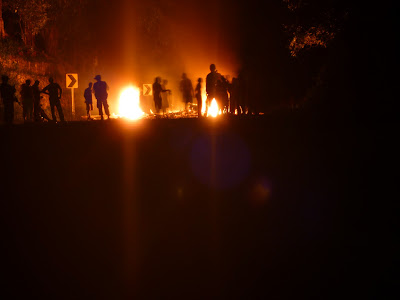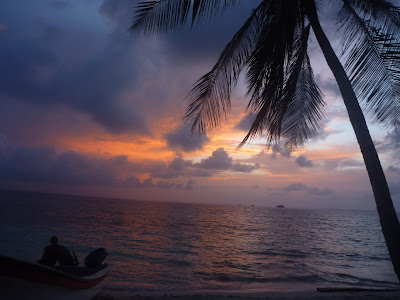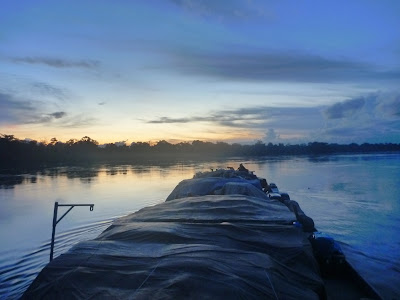The Darién Gap bewteen Colombia and Panamá is one of the most hostile jungle swamplands in the world, and is also the home to several Colombian para-military groups and to the main cocaine trafficking route to the USA. Many people have died or been kidnapped trying to cross it. I opted for another, more scenic, route.
 |
| San Blas Islands, Panamá |
I departed Cartegena, Colombia at 8:30 with only a few hours sleep after a full moon party the previous night. It took the shitty old bus over an hour to edge its way through the congested traffic and trundle its way through random suburbs before we even arrived at the bus terminal. I was then immediately thrown into a bus to Montería. Other than having to change buses half way because mine was too empty to continue, it was an uneventful, bumpy 7 hours. Then, while waiting for the very last vehicle of the day to my destination of Turbo, I watched a male police officer flirting with a female shop attendant, which culminated in a tickle fight and the woman squirming her way off the chair and onto the floor. All in a days work for the Colombian Police Force.
In the 4WD I was jammed into the back cab with 3 Colombians, including an obese woman. After a while of driving through the countryside in the dark, we stopped behind a line of parked trucks and cars in the otherwise deserted highway. Two soldiers bearing large weapons in hand informed us that there was a blockade ahead. ´OK, some sort of military checkpoint for drug trafficking,´ I thought. Then a gang of rowdy shouting men passed by with shirts wrapped around their faces, leaving only a slit for the eyes open. Their shirtless dark bodies were glistening with sweat under the nearly full moon.
I jumped down from the cab and walked around the truck parked in front. Further up the road I saw burning bonfires and many shirtless men with covered faces blocking the road. ´What´s going on?,´ I asked a fellow passenger. Its the ´Revolucionarios,´ he said. Knowing that this was one of the most dangerous parts of Colombia frequented by para-military groups trafficking cocaine to North America, suffice to say I was a little concerned. All of this occurring in Spanish added to my unease. But as the time passed and I saw several Colombians sleeping on the ground under their parked trucks I began to settle. I even got the confidence to go take a photo.
After asking around and getting several varied and vague answers, I found out that it was a protest from the local village who wanted to be connected to the electricity grid. So it was not guerrilla or para-military after all.
Eventually our driver decided that he was finished with waiting and burning blockades did not scare him. Despite no one else attempting to cross in the time we were there, our driver sped past the 20 or more vehicles parked ahead of us, almost leaving 2 of our passengers behind. He then eased his way around and over the blockade. The men were all shouting at us, but as we got closer I heard that they were only flirting with the girls in our car.
We continued on for several more hours on the shockingly bumpy road, gradually reducing in numbers as people where dropped off at their homes. Eventually it was just me in the back cab. At 1AM I arrived in Turbo, after over 12 hours of travelling. I checked into a cheap guesthouse and collapsed into bed.
When the port opened 5 1/2 hours later I got up to try and reserve a seat on the one daily speedboat to my destination. At 8:30 I returned with my bag and was squashed next to the captain out in the rain because they had over booked. He was already drinking port straight from the bottle. It was then a 2 1/2 hour ride across the gulf to Capurganá, the last town in Colombia and only a few kms from the Panamá border.
Upon arrival I wondered around the town and bumped into a cute French girl with dreadlocks riding a bicycle. She took me back to her guesthouse, where I met another guy, also with dreadlocks, who told me about a boat leaving for Panamá the next day. I then went on a mission to find an Italian called Fabio for the details. While there are sometimes infrequent and irregular departures, his was the only boat actually stopping in the San Blas Islands on the way for the next 10 days. While I wanted to spend more time in this cute little town, I had to take this opportunity. So I interrupted 2 men playing chess at the currency exchange office to sell my Colombian Pesos for US Dollars, went to immigration to get my exit stamp then made the most of my first and last day there. No cars, kids hassling you to take photos of them, men playing domino's under a coconut tree, heavily armed soldiers enjoying ice creams with child-like delight, horse drawn carts, old man dancing by himself and everyone super friendly and curious about you. Oh and the beach was pretty great as well. Pretty much what I imagined a little Colombian Caribbean fishing village would be like.
Later that night when I was about to go to bed the hippies came back and said they were going to the beach with other people to drink and play music. So we sat on logs on the beach with beers, Rum, instruments and some joints with a mixture of locals and foreigners, speaking Spanish.
After a delayed departure due to heavy rain and police checks, I climbed onto a little speedboat with Argentinians, Mexicans, Spaniards, Italians, French and Israelis, all of whom spoke Spanish. After a short ride we arrived in Puerto Obaldia, the first town in Panamá, where we got out passports stamped and our bags searched by sniffer dogs. It is indeed the main route for Colombian cocaine destined for the USA, but the traffickers usually ´forget´ to stop there for immigration formalities.
 |
| The Colombia-Panamá border |
We had lunch with fresh seafood and went for a walk around the village. A great place to be a kid, with children running around everywhere in packs, swimming, wrestling in the mud or playing with balls. Then we got back on the boat to go snorkeling off a nearby island. Super clear and warm water, but not heaps of coral. Someone saw some lobsters though.
I sat on the jetty for sunset writing in my journal and then speaking with an Israeli girl I had briefly met several months earlier in Peru. Just when I though the moment couldn´t get any better phosphorescent plankton started appearing everywhere, glowing fluorescent green.
We got up early the next day for 6 more hours of travel, with a short stop at an island with the biggest Kuna village. I got stuck in the worst spot on the boat, constantly getting sprayed with water and even using a mask and snorkel some of the way to keep the water out of my eyes.
But it was all worth it when we arrived at the island that would be my home for the next 2 days. A tiny island of about 100x50 M covered in coconut trees and cabins made of coconut trees, surrounded by white sand, Crystal clear shallow water and coral reefs. The San Blas Islands arguably have the best beaches in the world, alongside Polynesia in the Pacific ocean, and I could see why.
After lunch we went snorkeling right off the beach. Corals of alien design, fish of brilliant colours and starfish up to 1/2 M across. Some people saw a ray and a shark as well. Snorkeling is one of the few things that is as good now as when you were a kid, and I explored with child-like delight for hours. Most of the time I was with the Israeli girl, and when we swam in to shore we lay on the beach in awe of where we were. The water was so calm and glassy that we were able to rest our heads on the shore out of the water with our bodies in the water. We then went and watched sunset with the others.
The Kuna people are a matriarchal self-governing indigenous culture living on and managing the San Blas Islands. They provide for almost all of their needs, including vegetables and some other crops which they grow on the nearby mainland. They also do not have individual money within a family. As such, they are still coming to grips with what I would call basic economic theory. Two beds in a private cabin costs twice as much as two beds in an 8 person dorm; 1/2 L Rum costs $6 while 1 L costs $18; goods cost the same whether you by them on a remote island or beside a highway on the mainland.
The following morning we all went to another island 1/2 hour away which was even more spectacular, and the weather was perfect. I felt euphoric. After a period of hysterical laughter trying to come to terms with how beautiful it was, we smoked some weed and went snorkeling. The visibility was incredible and the coral and sea life mind blowing. Such a magical foreign world under there. There was also a quite large shipwreck directly off the shore.
We had lunch back at our island, then said goodbye to most of the group. Me and a few others had elected to stay another night and make our own way to the mainland. I went snorkeling again, this time making a whole lap of the island. As sunset approached I put my mask half under the water so that I could see half coral and fish and half sunset at the same time. I then joined the others on the beach to watch sunset.We just looked at each other in silence. Nothing needed to be said. It was one of the best days of my life
The following morning we said goodbye to our island and the Caribbean sea and took an hour boat ride to the mainland and up a river a way. We then took a jeep a couple of hours along honestly the most roller-coaster like road I have ever experienced, before arriving in Panamá City on the Pacific Ocean. With a huge modern skyline, this wealthy city felt a world away.
For more information on this route, check out:
http://www.facebook.com/sanblascolombia (Fabio was recently interviewed by Lonely Planet so may be in the next edition, and was organising buying his own, better, boat when we left him in Panamá City)
http://www.thedariengapster.com/ (has good info on the transport details)
Currently, these are the only 2 operators undertaking this route.












































